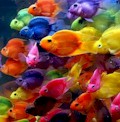Biological loading is a measure of the burden placed on the aquarium ecosystem by its living inhabitants. High biological loading in an aquarium represents a more complicated tank ecology, which in turn means that equilibrium is easier to disturb. In addition, there are several fundamental constraints on biological loading based in the size of the aquarium. The surface area of water exposed to air limits dissolved oxygen intake by the tank. The capacity of nitrifying bacteria is limited by the physical space they have available to colonize. Physically, only a limited size and number of plant and animals can be fit into an aquarium while still providing room for movement. Simply, all kinds of biology decay, and biological loading refers to that rate of decay in proportion to tank volume.
Aquarium ClassificationsFrom outdoor ponds and glass jars of antiquity, modern aquaria have evolved into a wide range of specialized systems. Individual aquaria can vary in size from a small bowl large enough for a single small fish, to huge public aquaria that can simulate entire marine ecosystems. A variety of different types of aquaria exist; for the most part, many of these classifications are based on the environment the aquaria intend to mimic.
One of the most basic ways to classify aquaria is their salinity. Freshwater aquaria are the most popular kind of aquarium due to their low cost and ease of maintenance. Marine aquaria generally require more complex equipment to set up and maintain than freshwater aquaria. Along with fish species, marine aquaria frequently feature a diverse range of invertebrates. Brackish water aquaria combine elements of both marine and freshwater fish keeping. Fish kept in brackish water aquaria generally come from habitats with varying salinity, such as mangroves and estuaries. Certain subtypes of aquaria also exist within these types, such as reef aquarium, a type of marine aquarium that house coral.
Another method to classify aquaria is their temperature range. Most aquarist maintain a tropical aquarium as these fish tend to be more colorful. However, the coldwater aquarium is also popular, which often includes fish such as goldfish.
Aquaria may be grouped by their species selection. The community tank is the most common type of aquarium kept today, where several non-aggressive species are housed peacefully together. In these aquaria, the aquarium fish, invertebrates, and plants probably do not originate from the same geographic region, but generally tolerate similar water conditions. Aggressive tanks, in contrast, house a limited number of species that can be aggressive toward other fish or are able to withstand aggression well. Species or specimen tanks usually only house one fish species, along with plants, perhaps found in the fishes' natural environment and decorations simulating a true ecosystem. This type is useful for fish that simply cannot be housed safely with other fish, such as the electric eel, as an extreme example. Some tanks of this sort are used simply to house adults for breeding.
Ecotype, ecotope, or biotope aquaria is another type based on species selection. In it, an aquarist attempts to simulate a specific ecosystem found in the natural world, bringing together fish, invertebrate species, and plants found only in that ecosystem in a tank with water conditions and decorations designed to simulate their natural environment. These ecotype aquaria might be considered the most sophisticated hobby aquaria; indeed, reputable public aquaria all use this approach in their exhibits whenever possible. This approach best simulates the experience of observing an aquarium's inhabitants in the wild. Matching a tank to the environment at the source of fish usually serves as the healthiest possible artificial environment for the tank's occupants.
